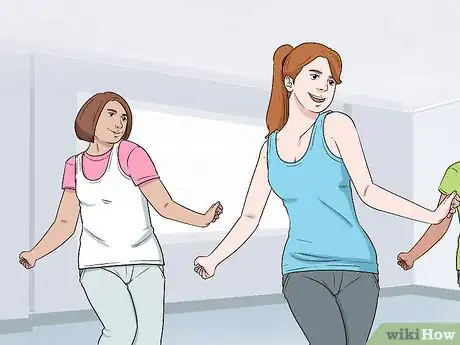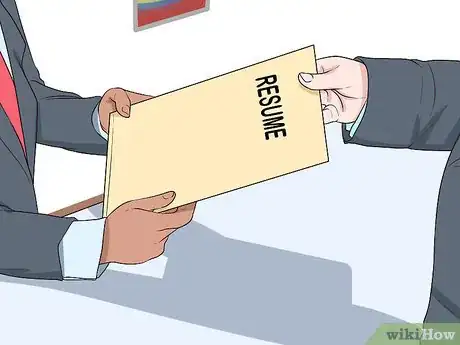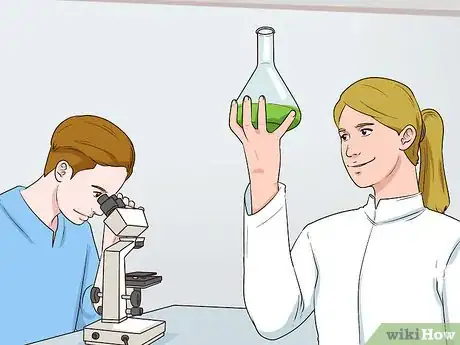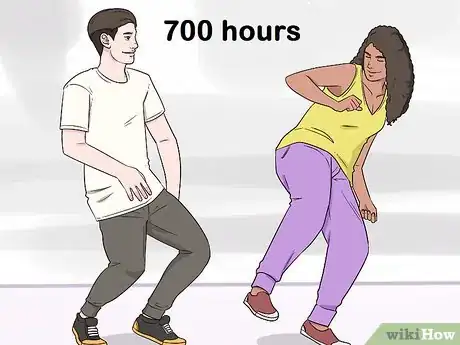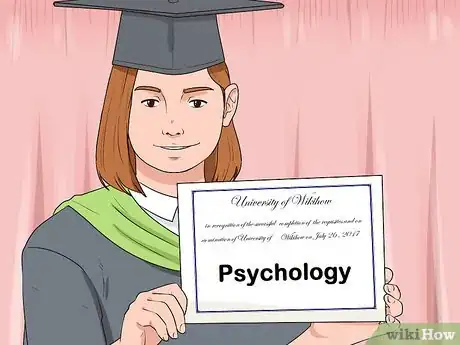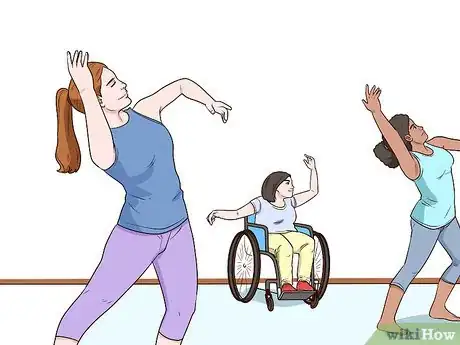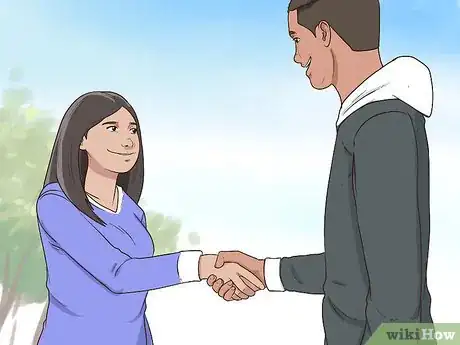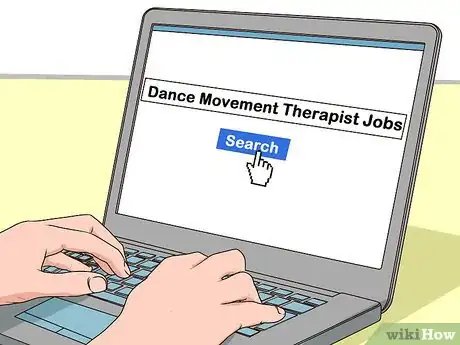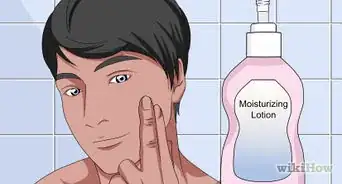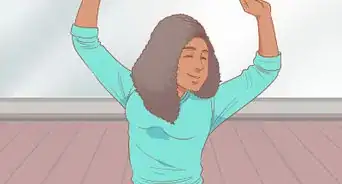This article was co-authored by wikiHow Staff. Our trained team of editors and researchers validate articles for accuracy and comprehensiveness. wikiHow's Content Management Team carefully monitors the work from our editorial staff to ensure that each article is backed by trusted research and meets our high quality standards.
This article has been viewed 19,463 times.
Learn more...
A dance movement therapist uses dance as a vehicle for physical and mental healing. They have a deep understanding of how different kinds of dance movement can be used to make people's lives better. If you would like to become a dance movement therapist, you will need to get an undergraduate and graduate college degree. These degrees in combination will teach you both the foundational understanding of dance and psychology needed for this career, as well as the specific techniques and theories used in a dance movement therapy practice.
Steps
Getting an Undergraduate Degree
-
1Study dance. In order to become a dance therapist you will need some background in dance. While in college, and even before that, it is a good idea to take a variety of dance classes. These classes will give you a basic understanding of the types of movement you will use for therapeutic purposes later on.
- To complete a graduate degree in dance movement therapy you need at least five years of experience is some sort of dance. That includes modern, ballet, jazz, tap, folk, or a specific type of ethnic dance.
- Some undergraduate dance classes will address key aspects of movement that you can use in your career down the line. This includes basic understandings of physiology and biomechanical principles of dance.[1]
-
2Take classes in psychology. Dance therapy requires that you have a thorough understanding of psychology, in addition to an understanding of dance. While a degree in psychology is not required to get into a graduate program in dance movement therapy, it is a good idea to learn about the field.
- Having a baseline understanding of psychology and psychological theory will help you as you move through your graduate program in the future.
Advertisement -
3Complete your degree. It does not matter what your undergraduate degree is in when working towards a career in dance therapy. As long as you have spent some time studying dance and psychology during your undergraduate education, you will meet the requirements for entering a master's degree program in dance therapy.
- However, if you know that you want to go into dance movement therapy, it is a good idea to focus your time on studying some aspect of dance, therapy, or psychology.
Completing a Master's Degree in Dance Therapy
-
1Search for an accredited dance movement therapy graduate program. There are a variety of accredited schools that have programs in dance movement therapy. To find the one that is right for you, look at the websites of dance therapy associations for lists of accredited programs. Once you pick programs that look good to you, contact the programs directly for more information.
- In the US, the American Dance Therapy Association website has a list of American programs.
- The Association of Dance Movement Psychotherapy UK maintains a list of professional training programs in the UK.
- The Dance Therapy Association of Australasia keeps an online list of all dance therapy programs in Australia, New Zealand, and nearby Pacific Islands.
- Take a variety of factors into consideration when picking the program that is right for you. Consider the cost, the location, the program requirements, and any other factors that you think are significant.
-
2Apply to a dance therapy master's degree program. While the application process may differ slightly for each individual school, they generally require you to write an essay explaining why you want to be a dance movement therapist. You will also need to submit your resume or CV, your school transcripts, and letters of recommendation from several people who can speak to your academic or professional qualifications.[2]
- If you really want to begin your graduate work in dance movement therapy as soon as possible, consider applying to several schools. This will increase the likelihood that you are accepted into a program.
-
3Complete your program coursework. Once you are accepted into a dance therapy program you will begin your coursework. The exact courses you will take in graduate school vary depending on your specific program, but they tend to include classes on biology, psychology, physiology, therapeutic practices, movement theory, and practice.[3]
- The program you enter should provide you with a general course requirement list and a plan of study. Following their plan of study should allow you to finish your degree in the time allotted.
-
4Do fieldwork and internship hours. After you complete your coursework, you still need some practical experience before you begin your career. To finish your master's degree in dance movement therapy you need to complete at least 700 hours of fieldwork and internship work. This will give you the time and ability to put what you have learned in the classroom to use in real-world situations.
- Internships and fieldwork assignments are typically assigned through your graduate program. Discuss your options for fieldwork and internships with the director of graduate studies in your department or with your specific graduate advisor.
Getting a Related Graduate Degree Instead
-
1Complete a master's degree program focused on human services. You do not need a master's degree that is specifically focused on dance movement therapy to become a dance movement therapist. However, you do need a master's degree that is related to the field in some way. Master's degrees in these fields will allow you to embark on a career in dance movement therapy:
- Psychology
- Counseling
- Social work
- Therapy
-
2Take training classes for dance therapy. Once you have completed a related master's degree, or as you are completing it, you can begin taking classes to get certification in dance movement therapy. If you are doing the alternate route to certification, classes do not need to be taken through a graduate program. Instead, they need to be taken through American Dance Therapy Association educators.
- Class requirements, educator information, and program specifications can be found on the website of the American Dance Therapy Association.
-
3Do fieldwork and an internship in dance movement therapy. Just as with the graduate degree in dance movement therapy, to get a certificate in dance movement therapy you will need to complete 700 hours of fieldwork and internship work to get your certification.
- If you are completing the alternative certificate program, you may need to find available fieldwork and internship assignments on your own or with the help of your certified teachers.
Starting and Advancing Your Career
-
1Discuss job opportunities with your internship and fieldwork supervisors. As you are finishing up your master's degree, you should be working on lining up a job. Discuss future job opportunities with your clinical supervisors. They may be impressed with your work and be willing to offer you a permanent job after graduation.
- Even if your supervisor cannot offer you a job, they may have some knowledge of other job opportunities in the field. They may also be able to point you towards other dance movement therapists that you can network with.
-
2Network at conferences and meetings. When you are starting your career it is a good idea to meet as many people in your field as possible. Conferences and association meetings are a great place to do this. The more people you meet, the more likely it is that you'll make a connection with someone who can help you in your career.
- Knowing people in your field can help you in several ways. They can give you leads to jobs or other dance therapists that might be hiring. They can also become part of your support and education network. This network of people will help you to become a great dance movement therapist.
-
3Look for job postings online. Most jobs in the field of dance movement therapy are posted on the websites of dance movement associations. Check the websites of the organizations in your area or in areas you would consider relocating to.
- You may also be able to find listings for dance movement therapy jobs through general job listing websites.
-
4Advertise yourself. Once you have finished your degree, you should add yourself to online lists of qualified dance movement therapists. These are typically located on the websites of dance movement therapy associations. Having your name and qualifications on these kinds of lists allow those looking for a dance movement therapist to find you.[4]
- It is also a good idea to advertise yourself by joining more general job-networking websites. This is another way that those looking for a qualified dance movement therapist can easily find you.
-
5Take continuing education classes. Even after your Master's degree is completed, it's important to keep learning about your field. This will allow you to learn about the newest theories and practices in the field. Take continuing education courses whenever you can so that your practice remains as up to date and relevant as possible.
- Lists of continuing education classes are typically available through your dance movement therapy association's website.
References
- ↑ http://hlknweb.tamu.edu/degrees-and-programs/undergraduate-degree-programs/dance-science
- ↑ https://www.antioch.edu/new-england/degrees-programs/counseling-wellness/dance-movement-therapy-and-counseling-ma/
- ↑ http://catalog.drexel.edu/graduate/collegeofnursingandhealthprofessions/dancemovementtherapyandcounseling/index.html#sampleplanofstudytext
- ↑ https://adta.org/find-a-dancemovement-therapist/
